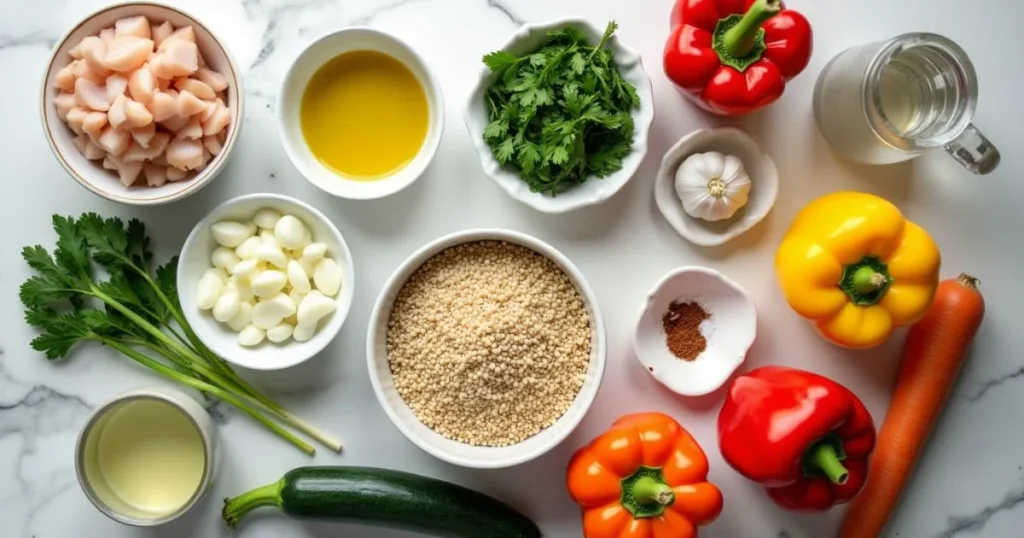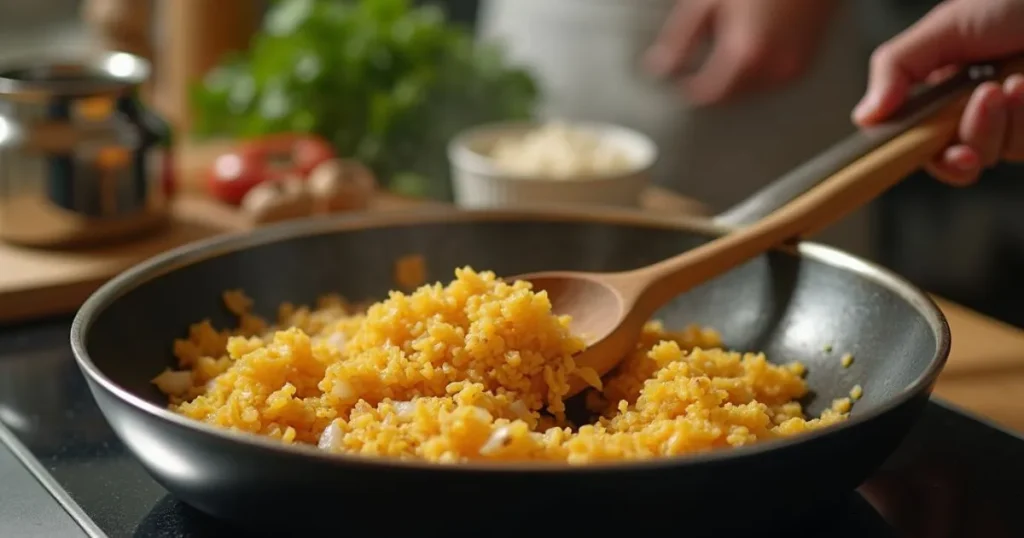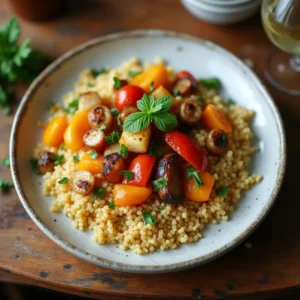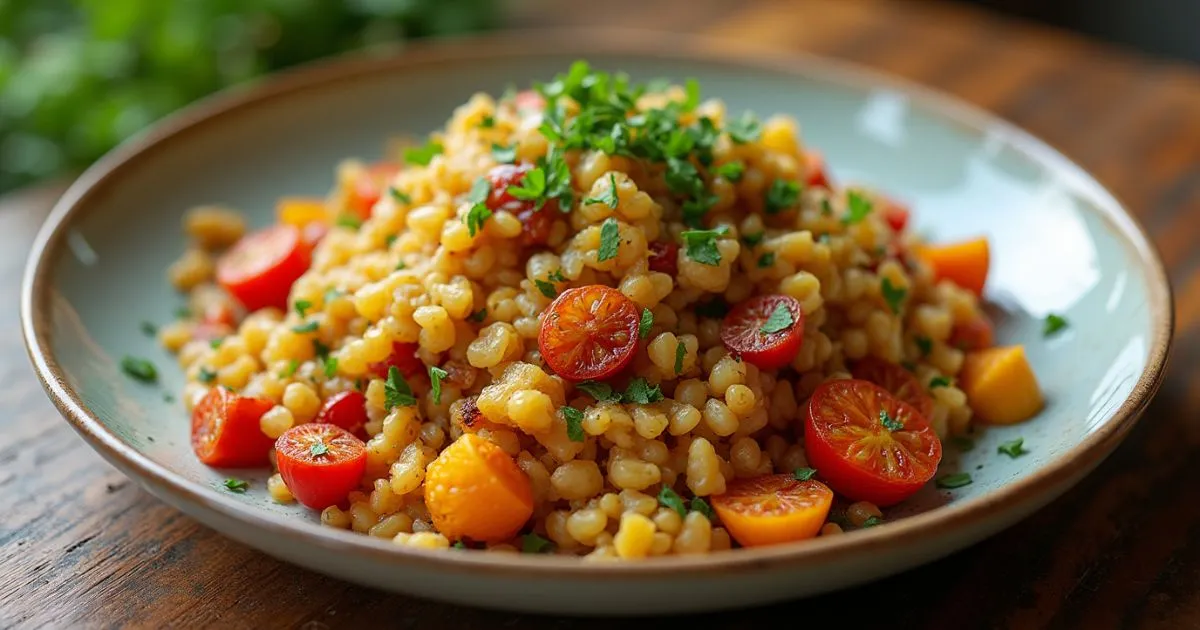Are you looking for a nutritious and satisfying way to enjoy kasha without the carbs? You’ve come to the right place! This low-carb kasha recipe is not only a great option for those watching their carb intake, but it’s also a delicious and versatile dish that fits perfectly into a healthy lifestyle. Packed with fiber, protein, and plenty of nutrients, this dish is perfect for anyone who wants to enjoy a filling meal without sacrificing flavor. Whether you’re on a low-carb diet or simply looking for a healthier twist on a classic, this recipe will quickly become a go-to favorite. Ready to transform kasha into a guilt-free delight? Let’s get started!
Table of Contents
1. Key Benefits
Let’s dive into some of the top benefits:
- Supports Weight Loss: Low-carb eating is known to help with weight management by promoting fat burning while keeping you full for longer. Kasha, when prepared with a low-carb approach, can make a satisfying meal that doesn’t spike your blood sugar levels.
- Nutrient-Rich: Buckwheat, the star ingredient of kasha, is naturally gluten-free and packed with essential nutrients. It’s an excellent source of fiber, magnesium, and antioxidants, which support heart health and help with digestion.
- Improves Blood Sugar Control: This low-carb kasha recipe helps maintain stable blood sugar levels. If you’re managing diabetes or just want to avoid sugar crashes, it’s a fantastic choice to add to your meal plan.
- A Great Source of Protein: Unlike other carb-heavy grains, kasha provides a hearty amount of plant-based protein. Protein is essential for muscle repair and overall body function, making this dish a great option for those looking to boost their protein intake.
- Versatile and Delicious: Whether you enjoy it as a side dish or a main course, low-carb kasha fits seamlessly into a variety of meal plans. Its mild, nutty flavor pairs well with vegetables, proteins, and healthy fats — giving you endless options to get creative in the kitchen.
2. Ingredients

To make a delicious low-carb kasha, you’ll need just a few simple ingredients. Whether you’re cooking for one or feeding the whole family, this recipe is both easy to prepare and full of flavor. Here’s everything you’ll need:
- 1 cup kasha (buckwheat): This is the base of the recipe. Buckwheat is naturally gluten-free and full of fiber, making it a great choice for a low-carb diet.
- 2 cups water or vegetable broth: This is used to cook the kasha. If you want to add extra flavor, go for vegetable broth instead of water.
- 1 tablespoon olive oil or butter (or a plant-based alternative): For a rich, savory taste, olive oil or a healthy butter alternative adds a nice finish to your kasha.
- 1/2 teaspoon salt: A pinch of salt enhances the natural flavors of the kasha and the broth.
- 1/4 teaspoon black pepper: Freshly cracked pepper adds a subtle heat that pairs perfectly with the nutty flavor of the buckwheat.
- Optional vegetables: Feel free to add diced onions, garlic, zucchini, or bell peppers for a more filling dish. These low-carb vegetables also pack in vitamins and nutrients.
- Herbs and spices (optional): To elevate the flavor, consider adding a pinch of dried thyme, rosemary, or parsley. Fresh herbs can also bring a burst of color and freshness.
- Protein options (optional): For a more substantial meal, you can add cooked chicken, tofu, or even a fried egg on top.
Pro Tips:
- Low-carb variations: If you want to make the dish even lower in carbs, consider substituting kasha with cauliflower rice or spiralized zucchini. Both options are excellent for those looking to reduce their carb intake even further.
- Make it vegan: Swap the butter or oil for coconut oil and add your choice of plant-based protein to make this recipe vegan-friendly.
- Flavor boost: Add a splash of lemon juice or a sprinkle of parmesan cheese for an extra kick of flavor.
With these ingredients, you’ll have everything you need to make a perfectly balanced and satisfying low-carb kasha. The best part? You can easily adjust it to match your individual tastes and dietary requirements. Enjoy experimenting with different veggies and proteins to create your ideal version!
3. How to Make Kasha Low Carb

Making kasha low carb is easier than you might think! Follow these simple steps to create a dish that’s both nutritious and delicious. Ready to dive in? Let’s get cooking!
- Rinse the Kasha:
Start by rinsing the buckwheat thoroughly under cold water. This helps remove any dust or impurities and ensures a clean, fresh taste. After rinsing, set the kasha aside to drain. - Toast the Kasha (Optional but Recommended):
In a dry pan over medium heat, toast the rinsed kasha for about 3-4 minutes, stirring occasionally. This step brings out the nutty flavor and adds a lovely depth to the dish. You’ll know it’s ready when it starts to smell toasty and aromatic. - Cook the Kasha:
Now, it’s time to cook the kasha. In a saucepan, heat 2 cups of water or vegetable broth until it reaches a boil. Once boiling, add a pinch of salt. Stir in the toasted kasha, reduce the heat to low, and cover the pan with a lid. Let it simmer for about 10-12 minutes, or until the liquid is absorbed and the kasha is tender. - Add Healthy Fats:
Once the kasha is cooked, add 1 tablespoon of olive oil or your preferred fat (like coconut oil or plant-based butter). Stir it in for a smooth, rich finish. This also adds healthy fats that support a low-carb lifestyle. - Season to Taste:
Sprinkle in black pepper and any additional herbs or spices you love. This is where you can really personalize your dish! Try adding garlic powder, thyme, or a dash of cayenne for extra flavor. - Optional Veggies:
If you’re adding vegetables, sauté them separately in olive oil until tender, and then fold them into the cooked kasha. Zucchini, bell peppers, or mushrooms are all great choices that won’t add extra carbs but will increase the meal’s fiber content. - Serve and Enjoy:
Once everything is well mixed and seasoned, give the kasha a quick taste test to adjust the seasoning if needed. Serve immediately as a side dish or enjoy it as a main by adding your favorite protein (chicken, tofu, or even a fried egg!).
In just a few simple steps, you’ll have a nourishing, low-carb kasha dish that’s as versatile as it is tasty. The combination of toasted buckwheat, healthy fats, and vibrant veggies is sure to satisfy your cravings without compromising on your healthy eating goals. Enjoy!
4. Pro Tips and Variations
Want to take your low-carb kasha to the next level? Here are some pro tips and variations to enhance your dish, add flavor, and make it truly your own. Whether you’re looking to adjust the recipe to suit your tastes or boost its nutritional value, these tips will help you create a perfect dish every time.
1. Toast the Kasha for Extra Flavor
To bring out the full, nutty flavor of the buckwheat, try toasting the kasha before cooking. Simply dry-toast the rinsed buckwheat in a pan for 3-4 minutes over medium heat until it’s lightly golden. This step adds depth to the taste and makes your dish even more aromatic.
2. Swap in Low-Carb Veggies
Want to boost the nutrition without adding carbs? Use low-carb vegetables like zucchini, spinach, or mushrooms. These veggies are not only nutrient-dense but also complement the earthy flavor of the kasha. You can sauté or roast the vegetables before adding them to your kasha.
3. Add Healthy Fats for Richness
Healthy fats can elevate the taste and texture of your kasha. Consider using olive oil, avocado oil, or ghee instead of butter for a richer, more satisfying meal. If you want to go dairy-free, coconut oil works wonderfully and adds a subtle, tropical flavor.
4. Spice It Up with Herbs and Seasonings
Experiment with herbs and spices to customize the flavor of your kasha. Fresh thyme, rosemary, or parsley are perfect for a fresh, aromatic touch. If you prefer a spicier kick, add a pinch of cayenne pepper or smoked paprika. These ingredients can easily turn your kasha into a flavorful side dish or the star of your meal.
5. Add Protein for a Complete Meal
For a heartier meal, top your kasha with a protein source. Try adding grilled chicken, roasted tofu, or a poached egg. This not only boosts the protein content but also makes the dish more filling. You can also add some cheese, such as crumbled feta or grated Parmesan, for an extra flavor boost.
6. Make It a Meal Prep Staple
This low-carb kasha recipe is perfect for meal prep. Make a big batch on Sunday and enjoy it throughout the week. Keep it in an airtight container in the refrigerator for up to 3 days. When reheating, you can add a splash of broth or a squeeze of fresh lemon juice to keep it moist and flavorful.
7. Experiment with Broth for Richer Taste
Using vegetable broth instead of water to cook the kasha imparts extra flavor and makes the dish more savory. If you want an even bolder taste, try using chicken broth or bone broth (if you’re not strictly vegetarian), which adds both richness and more protein.
5. Serving Suggestions
Now that your delicious low-carb kasha is ready, it’s time to think about how to serve it! Whether you’re serving it as a side dish or turning it into a main course, here are some ideas to inspire you and elevate your meal:
1. As a Side Dish
Kasha is a perfect low-carb side dish that pairs wonderfully with a variety of proteins. Whether you’re serving it with grilled chicken, roasted salmon, or a juicy steak, kasha’s earthy flavor will complement almost any dish. It’s a great alternative to traditional carb-heavy sides like rice or mashed potatoes, while still offering a satisfying and hearty texture.
2. Top with a Protein
To make your kasha a complete meal, consider adding a protein on top. A fried egg with a runny yolk is a popular choice, adding richness to each bite. You can also try grilled chicken, crispy tofu, or even some sautéed shrimp. If you prefer a vegetarian option, roasted chickpeas or tempeh are excellent sources of plant-based protein.
3. Stir in Vegetables for Extra Flavor
For a well-rounded meal, stir in a variety of vegetables to your kasha. Roasted or sautéed bell peppers, zucchini, and spinach add a vibrant pop of color and nutrition. You can even add a handful of fresh herbs like parsley or basil for an extra burst of flavor. The vegetables not only enhance the dish but also make it more filling and satisfying.
4. Serve with a Sauce
Kasha is versatile enough to pair with different sauces. Try drizzling a bit of tahini sauce, a squeeze of fresh lemon juice, or a light balsamic vinaigrette for a tangy, refreshing contrast to the nutty flavor of the buckwheat. For a creamy touch, consider adding a dollop of Greek yogurt or sour cream on top.
5. As a Breakfast Option
Believe it or not, kasha makes a wonderful breakfast option too! Serve it with a splash of almond milk, a sprinkle of cinnamon, and a handful of fresh berries for a warm, comforting start to your day. It’s a great low-carb alternative to oatmeal, providing both fiber and protein to keep you satisfied.
6. Pair with a Light Salad
For a lighter, fresh meal, serve your kasha with a side salad. A simple salad of mixed greens, cucumber, and cherry tomatoes dressed with olive oil and lemon is a great accompaniment. The crispness of the salad contrasts beautifully with the warmth and texture of the kasha, creating a balanced and healthy meal.
7. Meal Prep for the Week
Since kasha stores well in the fridge for up to 3 days, it makes an excellent option for meal prepping. Simply divide it into individual portions and pair with different proteins and veggies throughout the week for quick, nutritious meals.
With these serving ideas, you can enjoy your low-carb kasha in many delicious ways. From satisfying meals to light sides, it’s a dish that adapts beautifully to your needs. Enjoy!
6. Conclusion
Congratulations! You’ve just learned how to make kasha low-carb, and now you’re ready to enjoy a dish that’s both delicious and incredibly versatile. Whether you’re aiming for a healthy meal, a quick side, or something to meal prep for the week, this kasha recipe checks all the boxes.
Why You’ll Love This Recipe
This low-carb kasha is not only nutritious but also adaptable to a variety of tastes and dietary preferences. The buckwheat provides fiber and protein, making it a filling and satisfying choice without the excess carbs. Plus, with endless variations—whether you add protein, toss in some veggies, or experiment with different spices—you’ll never get bored of this dish.
As a culinary content creator, I’m always looking for ways to create recipes that are both healthy and satisfying. This low-carb kasha recipe is just one example of how easy it is to enjoy nutritious meals without compromising on flavor. Whether you’re cooking for one or making a large batch for the whole family, this dish will quickly become a favorite in your kitchen.
So, gather your ingredients, follow the simple steps, and enjoy the endless possibilities this low-carb kasha offers. I hope it brings both health benefits and flavor to your table. Happy cooking!

How To Make Kasha Low Carb
Ingredients
- 1 cup kasha buckwheat
- 2 cups water or vegetable broth for extra flavor
- 1 tbsp olive oil butter, or plant-based alternative
- ½ tsp salt
- ¼ tsp black pepper
Instructions
- Rinse the Kasha
- Rinse buckwheat under cold water to remove impurities. Drain and set aside.
- Toast the Kasha (Optional)
- Toast kasha in a dry pan over medium heat for 3–4 minutes until fragrant and golden.
- Cook the Kasha
- Bring 2 cups of water or vegetable broth to a boil.
- Add salt and toasted kasha, then reduce heat to low.
- Cover and simmer for 10–12 minutes until liquid is absorbed and kasha is tender.
- Add Healthy Fats
- Stir in olive oil or butter for a rich finish.
- Season to Taste
- Add black pepper and herbs like thyme or parsley.
- Optional Veggies
- Sauté onions, zucchini, or bell peppers separately and fold into the cooked kasha.
- Serve and Enjoy
- Top with protein like chicken, tofu, or a fried egg.
Notes
- Calories: 180
- Fat: 6g
- Protein: 7g
- Carbs: 20g
- Fiber: 5g
- Net Carbs: 15g
- Sugar: 1g
- Sodium: 5mg
7. FAQs
As you’re learning how to make kasha low carb, you might have a few questions along the way. To help you out, here are some of the most frequently asked questions about this recipe and some additional tips to make sure you get the best results.
1. Can I make kasha ahead of time?
Absolutely! Kasha is perfect for meal prep. You can cook it in advance and store it in the fridge for up to 3 days. If you make a big batch, simply reheat it in a pan with a little bit of water or broth to keep it moist. It’s a great option for quick lunches or dinners throughout the week.
2. Is kasha low-carb?
Yes! Buckwheat, the main ingredient in kasha, is naturally low in carbs compared to traditional grains like rice or pasta. It’s also rich in fiber and protein, making it a great choice for a low-carb diet. However, if you’re following a strict keto diet, make sure to check portion sizes, as the carbs can add up with larger servings.
3. Can I use something other than buckwheat for a low-carb alternative?
If you’re looking for a lower-carb option than buckwheat, you can try cauliflower rice. While it doesn’t have the same nutty flavor, cauliflower rice provides a similar texture and is even lower in carbs, making it an excellent substitute for those who need to limit their carb intake further.
4. What are some ways to flavor my low-carb kasha?
Kasha pairs wonderfully with a variety of seasonings and spices. Try adding a pinch of smoked paprika, thyme, rosemary, or garlic to enhance the flavor. You can also mix in some lemon juice for a fresh, zesty kick. For those who enjoy heat, a dash of cayenne pepper or chili flakes can spice things up!
5. Can I make kasha gluten-free?
Yes! Kasha is naturally gluten-free, so it’s a great option for those following a gluten-free diet. Just be sure to double-check that your buckwheat is labeled gluten-free if you have severe sensitivities or celiac disease.
6. What should I serve with low-carb kasha?
Kasha is extremely versatile and can be paired with almost anything. For a balanced meal, try adding grilled chicken, shrimp, or roasted vegetables. It also works well as a side dish to meats like steak or salmon. For a vegan version, add sautéed tofu or chickpeas for extra protein.
7. How do I store leftover kasha?
Store any leftover kasha in an airtight container in the refrigerator. It keeps well for about 3 days. You can also freeze it for up to a month if you want to store it for longer periods. Just make sure to reheat it thoroughly before serving.
8. Can I make kasha sweet instead of savory?
Yes! Kasha can be used for both sweet and savory dishes. To make a sweet version, try cooking it with almond milk and adding cinnamon, vanilla extract, and a drizzle of honey or maple syrup. Top it with fresh berries or nuts for a delicious breakfast alternative.
These FAQs should help guide you as you make your low-carb kasha. Whether you’re looking to tweak the recipe or experiment with new flavors, there’s plenty of room for creativity in the kitchen. Enjoy the journey, and happy cooking!
Recipe Recap: Low-Carb Kasha
Recipe Details:
- Prep Time: 10 minutes
- Cook Time: 20 minutes
- Total Time: 30 minutes
- Servings: 4
- Calories: 180 per serving
Nutrition Information (per serving):
- Calories: 180
- Fat: 6g
- Protein: 7g
- Carbs: 20g
- Fiber: 5g
- Net Carbs: 15g
- Sugar: 1g
- Sodium: 5mg
Categorize the Recipe:
- Course: Main Dish, Side Dish
- Cuisine: Eastern European, Healthy
- Diet: Low-Carb, Gluten-Free
- Method: Stovetop, Meal Prep
- Keyword: Low-Carb Kasha, Healthy Kasha Recipe, Kasha Meal Prep
- Skill Level: Beginner to Intermediate
This low-carb kasha recipe is a flavorful, nutritious dish that’s perfect for meal prepping or serving as a healthy side or main course. With minimal ingredients and a simple stovetop method, it’s easy to prepare yet offers versatility in flavor and serving options. Enjoy it on its own, or pair it with your favorite protein or vegetables for a balanced meal.
